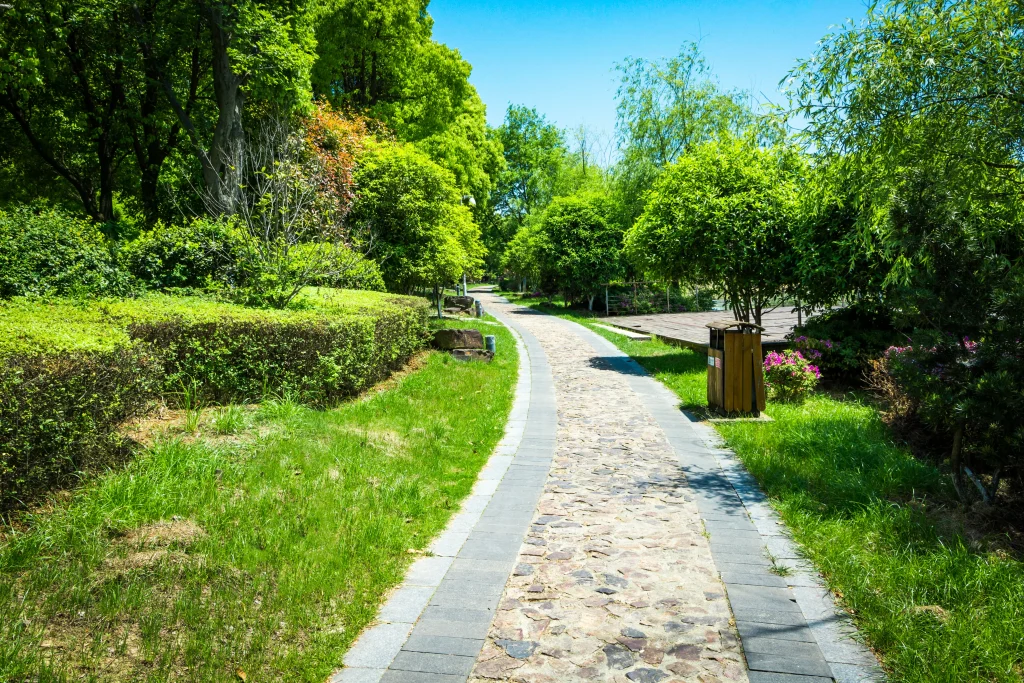An uneven lawn disrupts your property’s visual harmony and signals underlying health issues in your grass. When some sections grow lush while others remain sparse, factors like soil composition, water distribution, and maintenance practices are typically responsible.
This guide presents 10+ proven solutions to transform your inconsistent lawn into a uniform, vibrant landscape. By addressing root causes rather than symptoms, these methods restore balance to your turf and establish conditions for sustained health.
Why Is Grass Growing Unevenly?
Uneven Soil Composition
Soil beneath your lawn determines how grass grows above. The composition varies across your property, affecting grass health through:
- Variable water retention: Some areas hold moisture while others drain rapidly
- Inconsistent nutrient distribution: Certain sections receive ample nourishment while others lack critical minerals
Key signs to watch for:
- Water pooling in some areas after rain
- Perpetually dry patches elsewhere
- Dense, lush growth in moisture-retaining zones
- Thin, struggling grass in quick-draining spots
Grass roots need consistent access to water, oxygen, and nutrients to thrive. When soil composition varies dramatically, roots develop unevenly – robust in favorable conditions but shallow in poor soil. This foundation issue requires correction before surface-level improvements can succeed.
Poor Lawn Care Practices
Your maintenance routine directly impacts growth uniformity through:
Mowing issues:
- Cutting too short (“scalping”) exposes soil to sunlight
- Following identical mowing paths compresses soil in wheel tracks
- Mowing wet grass tears rather than cuts, creating ragged patches
Fertilization mistakes:
- Inconsistent application creates dark green sections next to pale areas
- Over-application near starting points creates feast-or-famine conditions
- Applying during drought or extreme heat damages grass
These basic maintenance errors compound over time, creating increasingly visible growth disparities across your lawn.
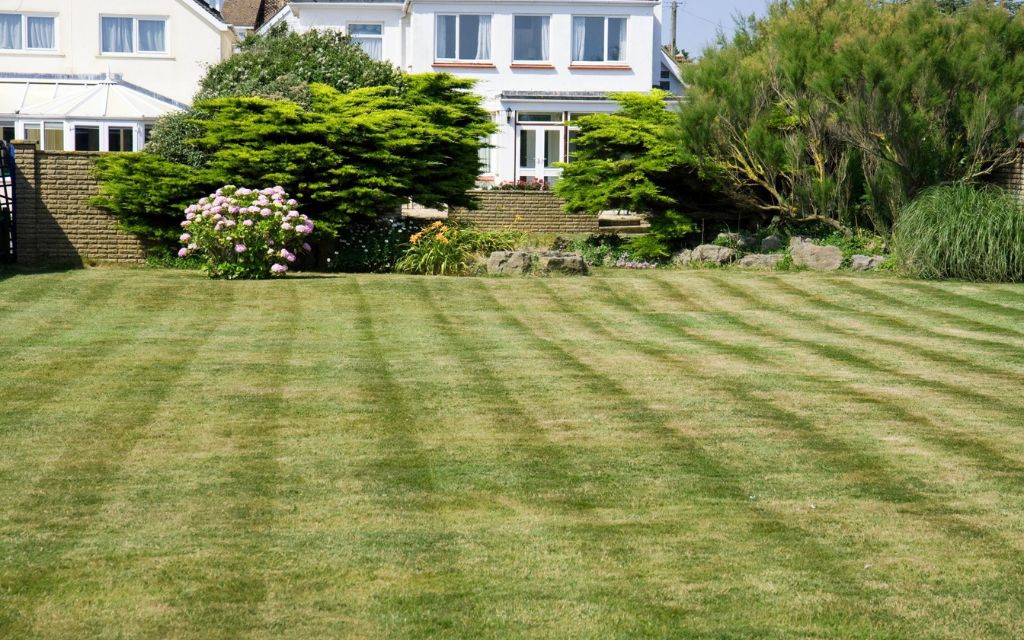
Inconsistent Watering
Water distribution problems rank among the primary causes of uneven growth. Most irrigation systems fail to deliver uniform coverage, creating overwatered zones alongside drought-stressed patches.
Sprinkler system deficiencies create obvious patterns—circular green patches around sprinkler heads with yellowing grass between coverage zones. Manual watering often worsens the problem, as most homeowners naturally concentrate on convenient areas while neglecting remote lawn sections.
Seasonal changes affect water needs, requiring system adjustments many homeowners overlook. As temperatures rise, water evaporates faster, leaving some areas drought-stressed. During cooler months, reduced evaporation leads to waterlogging in low-lying sections. This seasonal variability demands responsive irrigation management to maintain even growth.
Shade and Sunlight Variability
Light exposure varies dramatically across most properties, creating natural growth disparities between sun and shade zones.
Most grass varieties require 4-6 hours of direct sunlight daily for optimal growth. Areas beneath trees or buildings receive significantly less, resulting in thinner growth with elongated blades as grass stretches toward available light.
The contrast becomes obvious during growing season—vibrant, thick turf in sunny sections juxtaposed with sparse, weaker growth in shadowy areas. This pattern often worsens as trees mature and shade patterns expand, gradually thinning previously robust sections.
Pest and Disease Issues
Localized pest and disease problems create distinct patches of struggling grass. Grubs feed on grass roots beneath the surface, creating irregular dead patches that lift easily when pulled. Chinch bugs extract plant juices, leaving expanding brown areas, particularly during hot weather.
Fungal diseases manifest as circular patterns—brown patch produces brownish rings, while dollar spot creates silver-dollar-sized discolorations. These infections spread unevenly, affecting stressed grass first and creating a patchwork appearance across your lawn.

Soil Compaction
Repeatedly walking, playing, or driving on lawn areas compresses soil particles, reducing air pockets grass roots need to thrive. Compacted soil restricts root penetration, limiting access to water and nutrients even when present.
High-traffic pathways, children’s play areas, and zones beneath heavy equipment show the most severe compaction effects. Clay soils prove particularly susceptible compared to sandy compositions. Left unaddressed, compaction worsens annually, creating increasingly obvious growth patterns across your lawn.
Incorrect pH Levels
Soil pH fundamentally affects nutrient availability, with most grasses preferring slightly acidic conditions (6.0-7.0). When pH levels vary across your property, grass grows unevenly despite identical maintenance.
Acidic soil (below 5.5) locks up essential nutrients like phosphorus and calcium, while alkaline conditions (above 7.5) reduce iron and manganese availability. These imbalances manifest as yellowing patches despite adequate fertilization. Colorado soils typically trend alkaline, especially in Denver and surrounding areas, often requiring targeted amendments.
How to fix an unevenly growing lawn?
Conduct a Professional Soil Test
A comprehensive soil test reveals the specific deficiencies creating uneven growth across your lawn. While basic DIY test kits provide pH readings, professional tests analyze nutrient levels, organic content, and soil composition—factors critical to developing targeted solutions.
The resulting test report serves as your lawn recovery blueprint, eliminating guesswork and preventing wasteful application of unnecessary products. Rather than blanket treatments, you’ll apply exactly what each section needs—lime for acidic spots, sulfur for alkaline areas, and specific nutrients for deficient zones. This precision approach accelerates recovery while minimizing environmental impact.
Implement Core Aeration
Break through compacted soil using mechanical core aeration. This process removes small soil plugs, creating channels for air, water, and nutrients to reach grass roots. For Denver’s clay-heavy soils, aeration proves particularly effective at reversing compaction that prevents even growth.
After aeration, your lawn gains immediate breathing room, with roots expanding into newly available space. Water penetrates more uniformly, reducing runoff and promoting even moisture distribution. This single intervention often creates noticeable improvement within weeks, particularly in heavily trafficked areas.
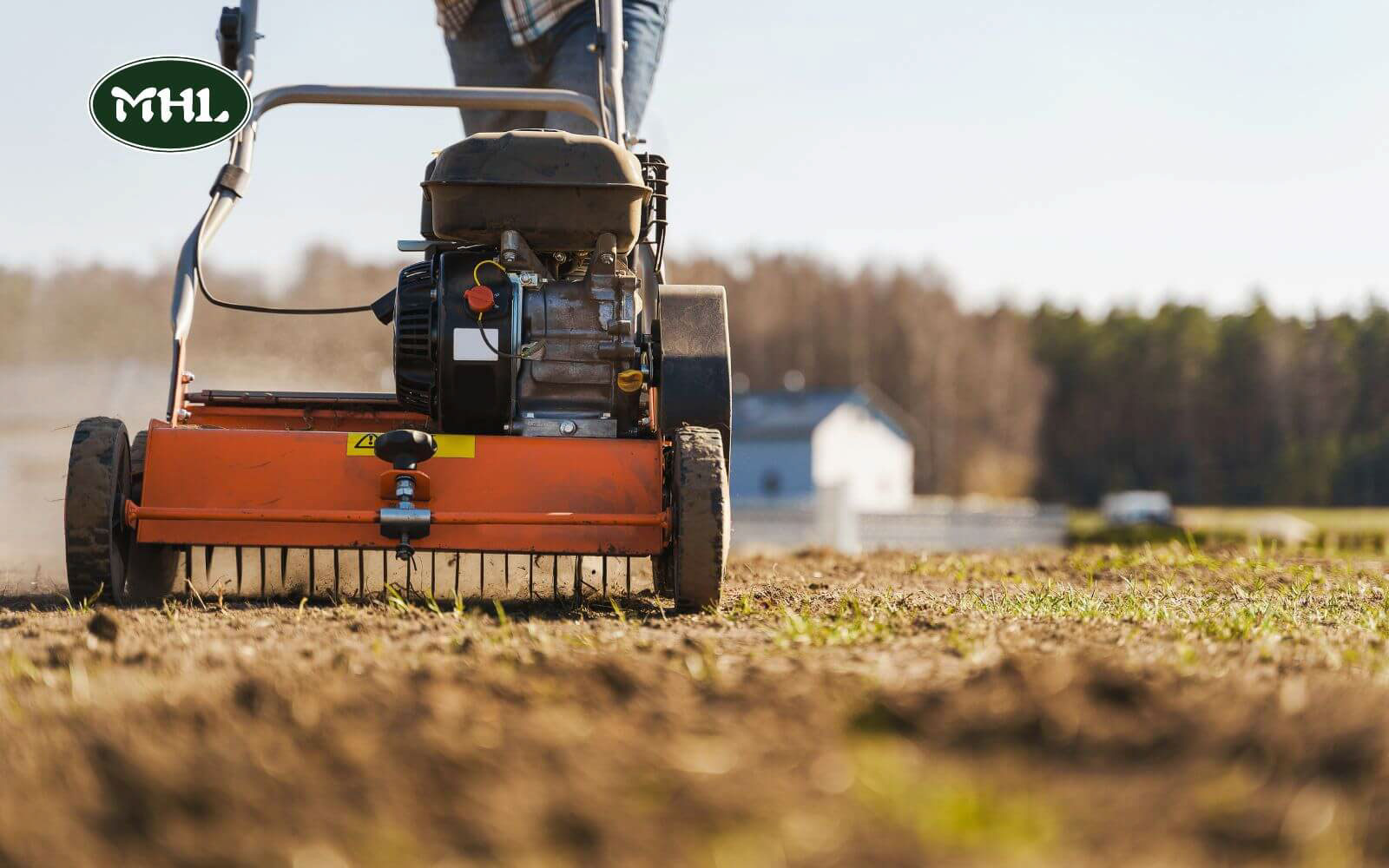
Apply Top Dressing to Level the Surface
Address surface irregularities by applying a thin layer of quality topsoil across uneven areas. This technique, called top dressing, gradually fills low spots without suffocating existing grass. Select topsoil that matches your existing soil composition to ensure consistent growing conditions.
Apply no more than ½ inch of material at once, using a rake to distribute it evenly between grass blades. For significant depressions, repeat applications every few weeks rather than applying excessive material at once. The soil should filter down to lawn base level, leaving grass tips exposed.
Over several applications, depressions fill in permanently, creating a smoother, more uniform surface that supports even growth across previously inconsistent areas.
Establish Proper Mowing Techniques
Correct cutting practices significantly improve growth uniformity. Set mower height to 3-3.5 inches for Colorado lawns, removing no more than one-third of blade height in a single mowing. This height balance promotes deeper root growth while reducing stress on grass plants.
Mow when grass is dry to ensure even cutting and prevent clumping. Allow clippings to remain on the lawn when possible—they return valuable nutrients to the soil and improve organic content.
Create a Strategic Watering Plan
Develop a consistent irrigation schedule based on grass needs rather than calendar convenience. Water deeply (about 1 inch) but infrequently (2-3 times weekly) to encourage deep root development. Early morning watering (4-9 AM) maximizes absorption and minimizes evaporation loss.
For non-irrigated lawns, invest in quality sprinklers that provide consistent coverage. Move them systematically to ensure uniform watering, and time each zone precisely. During drought conditions, prioritize watering stressed areas while maintaining minimum moisture in healthier sections. This balanced approach prevents both overwatering and water stress that lead to uneven growth.

Implement Targeted Fertilization
Replace blanket fertilization with a strategic approach targeted to specific lawn sections. Apply fertilizer based on soil test results, using different formulations for areas with varying needs.
For example, high-nitrogen products for yellowing sections and balanced formulas for established areas.
Select slow-release fertilizers that provide consistent nutrition over time rather than creating feast-or-famine cycles. These products minimize growth surges that accentuate lawn unevenness.
For precise application, use a broadcast spreader with an edge guard to ensure consistent distribution.
Overseed Thin or Bare Areas
Introduce new grass into struggling lawn sections through strategic overseeding. Select grass varieties matched to your specific conditions—drought-resistant fescues for sunny areas and shade-tolerant varieties for tree-covered sections.
For Denver-area lawns, consider Kentucky bluegrass blends with perennial ryegrass for durability.
Prepare seeding areas by mowing short (2 inches) and raking to expose soil surface. Apply seed at recommended rates using a spreader for even distribution. Cover freshly seeded areas with a thin layer of compost to retain moisture and protect seeds.
Water newly seeded sections lightly twice daily until germination occurs (typically 7-14 days), then gradually reduce frequency while increasing watering depth. Overseed annually as preventative maintenance to maintain consistent thickness across your entire lawn.
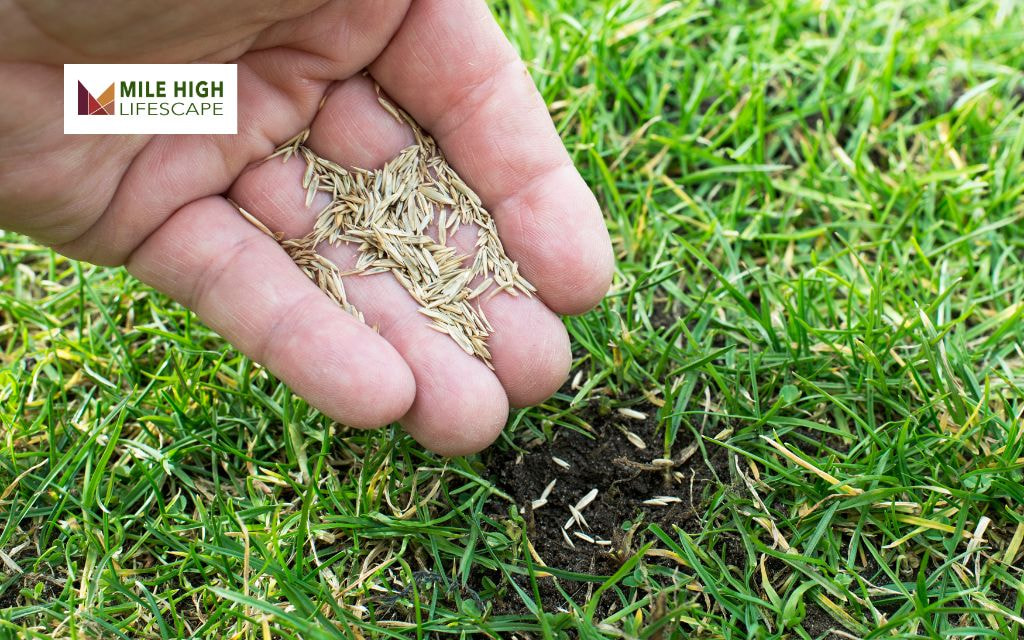
Adjust for Shade Conditions
Transform struggling shady areas by making specific adaptations. Prune lower tree limbs to increase light penetration, focusing on removing branches below 8-10 feet. This simple adjustment increases available sunlight without sacrificing tree health or shade benefits.
Modify maintenance practices in shaded sections—raise mowing height by ½ inch, reduce fertilizer by 25%, and water less frequently but more deeply. These adjustments acknowledge the different growing environment under trees and structures. For extremely dense shade, consider attractive groundcover alternatives like moss or hostas that thrive where grass struggles.
Address Drainage Issues
Correct water flow problems that create perpetually soggy or dry areas. For minor depressions where water collects, implement the top dressing approach outlined earlier. More significant drainage issues require installation of French drains or dry wells to redirect excess water away from problem areas.
Install rain gardens in natural collection points to capture excess water while creating attractive landscape features. These strategic interventions balance moisture levels across your property, eliminating both waterlogged patches and drought-stressed areas that create uneven growth patterns.
Treat Lawn Diseases and Pests
Identify and address specific organisms creating patchy growth. For fungal diseases like brown patch or dollar spot, apply targeted fungicides only to affected areas rather than treating the entire lawn. Improve air circulation around these spots by reducing watering frequency and trimming surrounding vegetation.
Combat grub infestations by applying beneficial nematodes or appropriate insecticides during early development stages (typically June-July in Colorado). For surface-feeding insects like chinch bugs, use insecticidal soap applications focused on damaged areas to prevent further spread.
Reduce thatch through dethatching or aeration, avoid evening watering that promotes fungal growth, and maintain proper mowing height to increase resilience. These preventative measures, combined with prompt treatment of any new outbreaks, maintain uniform lawn health across all sections.
Balance Soil pH Levels
Correct pH imbalances identified through soil testing. For acidic areas (below 6.0), apply agricultural lime at rates specified in your soil test report. Limestone materials raise pH gradually, creating more favorable conditions for nutrient availability and grass growth in previously stunted areas.
Address alkaline sections (above 7.0) common in Colorado soils by applying elemental sulfur, iron sulfate, or acidifying fertilizers. These amendments gradually lower pH, unlocking nutrients previously unavailable to grass roots. Because pH correction occurs slowly, retest soil annually to track progress and adjust treatment.
Apply amendments during aeration when possible, allowing materials to enter soil channels for faster incorporation. Follow application with thorough watering to activate amendments and begin the chemical processes that balance pH. This fundamental soil correction creates conditions where grass can access nutrients uniformly across your entire lawn.
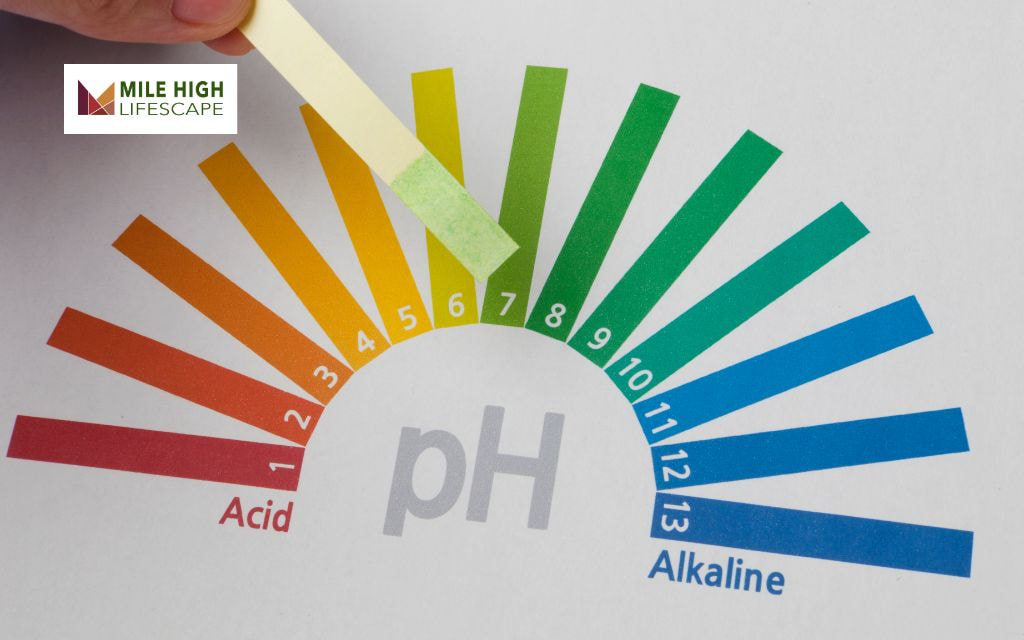
Long-Term Lawn Maintenance for Even Growth
Maintaining uniform growth requires consistent practices rather than occasional interventions. Establish a comprehensive annual maintenance calendar that schedules core tasks—aeration, overseeding, fertilization, and soil testing—at optimal times.
For Colorado lawns, plan major maintenance during spring (April-May) and fall (September-October) when moderate temperatures support recovery.
Practice preventative rather than reactive maintenance. Apply pre-emergent weed control before germination cycles, test soil before deficiency symptoms appear, and overseed thin areas before bare spots develop. This proactive approach prevents the pronounced unevenness that reactive treatments struggle to correct.
Invest in professional services for technical tasks that require specialized equipment or expertise. Mile High Lifescape provides comprehensive lawn care programs that incorporate soil testing, precision aeration, and targeted treatments tailored to Denver’s unique growing conditions. These scheduled professional interventions complement your routine maintenance for optimal results.
Frequently Asked Questions (FAQs)
How long will it take to fix my uneven grass growth?
Expect visible improvement within 4-6 weeks after implementing the recommended treatments, with substantial changes apparent within one growing season. Major problems like severe compaction or significant pH imbalances may require 6-12 months for complete correction. Consistent maintenance after initial correction prevents regression and maintains uniformity.
Should I remove topsoil and start over with my lawn?
Complete lawn renovation proves necessary only in extreme cases—extensive weed infestation, improper grading, or severely damaged soil. Most unevenness responds to the targeted approaches outlined above without the expense and disruption of complete replacement. If considering renovation, consult Mile High Lifescape professionals for an expert assessment of whether less invasive options might succeed.
How often should I aerate my lawn to prevent uneven growth?
For Colorado’s clay-heavy soils, annual aeration provides significant benefits. Lawns with high traffic or visible compaction may require bi-annual treatment (spring and fall). Sandy soils may perform adequately with aeration every other year. Monitor your lawn’s response—if water begins pooling or grass thins in sections despite proper care, schedule additional aeration.
Can I fix grass growing unevenly during winter months?
While major interventions should wait for growing season, winter allows for planning and soil testing. Use dormant months to analyze your lawn’s patterns, research appropriate grass varieties, and prepare equipment. Apply winter fertilizer in late fall to strengthen roots, and control winter weeds that create spring bare spots. Full correction requires active growth, but preparation during dormancy accelerates spring recovery.
What grass varieties work best for achieving uniform growth in Denver?
For sunny sections, Kentucky bluegrass remains the standard for Colorado lawns, offering excellent recovery from damage and uniform growth patterns. Blend with 10-20% perennial ryegrass for faster establishment in bare areas. For shaded sections, fine fescues provide consistent performance with minimal light. Tall fescue offers drought resistance for challenging areas. Mile High Lifescape recommends specific blends tailored to your property’s unique conditions.
